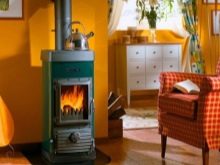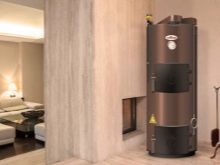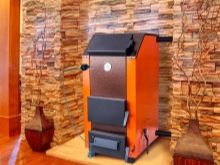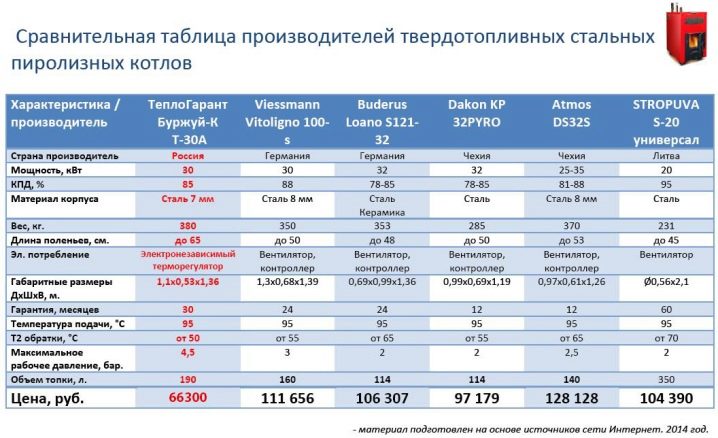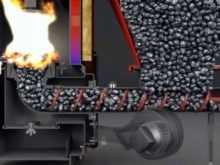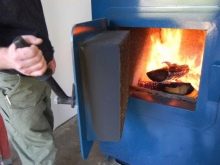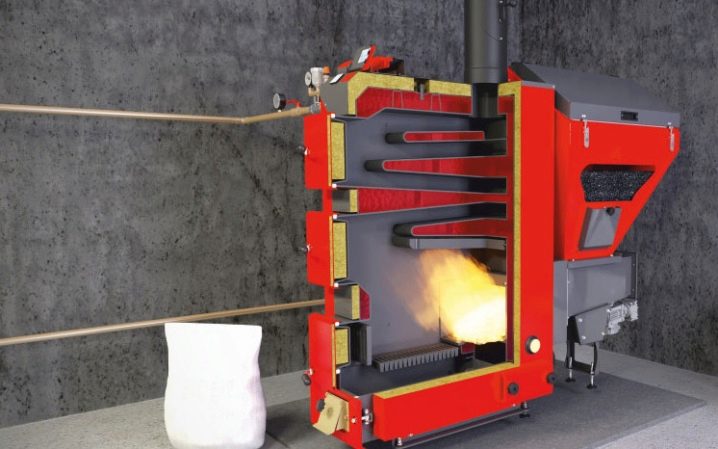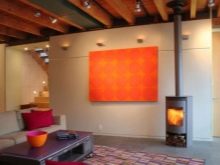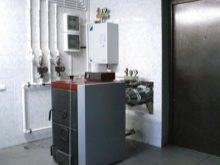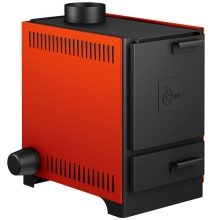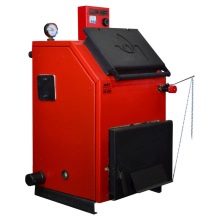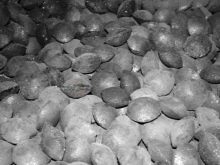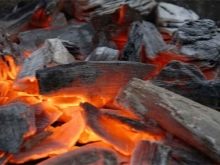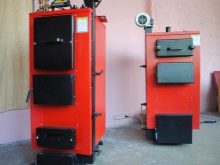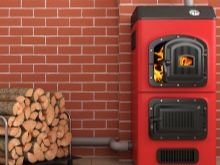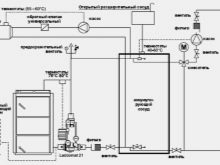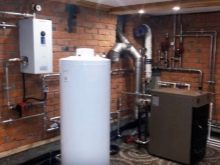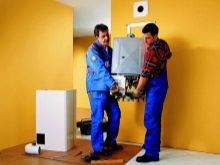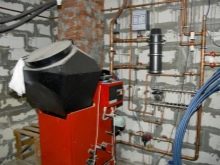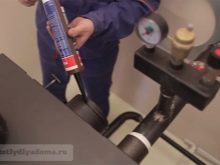Coal boiler: device and installation details
The use of coal for heating has a long history. But it is not necessary to use a classic oven. There are more modern designs - boilers that you need to choose the most carefully and scrupulously.
Special features
Modern coal boiler is characterized by versatility of use. All systems that can burn coal work quite well on wood, fuel briquettes, pellets, and various household garbage. The energy released during the combustion of anthracite is quite high. You can use it to heat both the air directly and the intermediate water circuit. Used modern technology allows to extend the duration of the combustion of a single portion of the fuel.
Principle of operation
Coal-fired boilers for private houses burn pledged fuel from bottom to top. Obligatory moment in the work of the design is to monitor the rate of flow of fresh air. This means that the combustion process is controlled from start to finish. A very important feature of the latest generation of equipment is the automated supply of fuel. It largely frees owners from dirty, time-consuming and very difficult work.
The supply of new portions of fuel to the furnace is usually carried out by the work of a screw conveyor. Differences in heating systems are mainly due to the auger design: compared to pellet-powered devices, it should be more massive and stronger. The device will be able to perform the heating function only when it will burn fuel of strictly specified characteristics. Humidity is clearly limited, because when it is exceeded, the heating efficiency is sharply reduced. More detailed instructions on this account, including the operating modes of the burner, contains a regime map for a specific apparatus.
Not always the average consumer can understand for himself what exactly is written there.But it is worth keeping such documentation so that service technicians can understand these or other nuances. The standard regime map is formed strictly according to the model approved in 1984.
It indicates:
- the recommended proportion of carbon monoxide in relation to oxygen and carbon;
- Heat system efficiency;
- heat loss rate in general;
- heat loss during operation of the heater;
- steam generation rate;
- gas and air pressure in the burner;
- temperature of the steam being created.
A special form of the map is used when using an injection burner. Then the air pressure indication is replaced by a description of the placement of the nodes, such as a control valve and the curtains of the blower sheet. Additionally, it can sign where the profile valves and the bypass window proportional valve are located. Almost always, an economizer mode card is attached to coal-fired boilers. Important: regime maps are updated in case of any system re-profiling, its re-equipment.
Advantages and disadvantages
Judging by the feedback from users, coal-powered units manifest themselves in no way worse than gas or liquid analogues.They are very good where you want to provide heating in the absence of connection to the central gas pipeline. The temperature of combustion and exhaust gases is determined by the choice of the designers of the classical or pyrolysis schemes. Compared to other fuels, coal has a very high thermal efficiency.
However, it is important to remember the weak points of the structure:
- have to use a fan that is not operational when a power outage;
- the cost of a high-quality coal boiler is very high, wood models are sold much cheaper;
- in comparison with burning wood, carbon monoxide output increases, which means the need to equip a boiler room away from the living space;
- more soot, soot and dust are emitted which inevitably smudges everything around.
On the other hand, if you choose between different types of solid fuels, coal will be the most powerful fuel. Particularly convincing is the difference in large houses where it is necessary to supply a lot of heat to radiators. Some weaken the inherent disadvantages of coal fuel and further improve the efficiency of work by choosing pyrolysis structures.In turn, they will cost much more than simple solid-fuel vehicles. And not least, coal for the same heating costs much less than electricity.
Kinds
Thanks to the efforts of engineers, coal-fired boilers have ceased to be something uniform and uniform, as it was a few decades ago. The widespread use of automatic long-burning systems is due to the growing concern for heating efficiency. The cost of any fuel and energy produced is growing steadily. The benefit of long-term combustion of a single portion of the fuel lies in the fact that it relieves a large amount of people from routine control. There is no need to continuously monitor the operation of the equipment and to throw all the time new fuel.
The characteristic problem of old stoves, which even when hot in the evening turned out to be icy in the morning, was solved successfully. Reducing the amount of unburned residue can reduce the amount of ash produced. And its disposal is a serious problem for any private house; because the burned coal, unlike wood, cannot be used for fertilizing vegetable gardens.
It becomes possible to perform routine maintenance in the intervals between the fuel tabs, soot emission is reduced. Eliminates the characteristic feature of solid-fuel equipment of manual type, which is easily overheated.
You should not assume that the long-burning boiler is an ideal device for all in general. The use of sophisticated and carefully tuned automation increases the cost of the mechanism by up to 100%. There is a dependence on the power grid, which even the backup power devices are not completely eliminated. To a large extent, these drawbacks overlap with impressive efficiency. But still, where the electricity supply is unstable, it is worth thinking about choosing more traditional devices.
Transitional level between these types of technology are semi-automatic devices. The duration of autonomous action in the best models of this kind reaches 20-24 hours. Compared to manually operated boilers, the dimensions of the firebox and heat exchanger are increased.
Typically, the design includes:
- bottom door for ash;
- middle passage for heating;
- cleaning the heat exchanger through the hatch above.
Some models are equipped with only two doors, in this case, the top combines the functions of cleaning the heat exchange unit and the entrance for fuel. Ignition must be made manually, as soon as the flame comes on, automatic equipment enters the work. Be sure to have a microprocessor that monitors the operation of the fan blowing air. The action of this fan sets the rate of pumping air into the area where the coal burns. Accordingly, the rate of combustion of the fuel mass changes.
Depending on the complexity of the regulatory systems, their action may imply a stepwise or smooth adjustment. In the simplest mode, the controller responds to a temperature descent below the planned value.
More practical are complexes with PID automation, which additionally take into account the temperature:
- hot water circuit;
- exhaust gases;
- room air.
In a semi-automatic boiler, you can burn coal that has not been calibrated. Both lignite and coal fuel should not have a particle size of less than 1 cm. For firewood, the depth of the combustion chamber is critical, it limits the allowable length of logs.If you plan to use chips, each of them must be at least 1 cm in length. Moisturizing is also recommended.
The shaft principle of the firebox is considered more practical than other options. Vertically loaded fuel not only burns more efficiently than usual. It releases heat for a longer time and releases less toxic gases into the atmosphere. Compared with simple "boxes", the efficiency of the equipment really grows. Manufacturers are constantly conducting experiments to find the best versions of heat exchangers, lining, forms of the shaft channel and so on.
A large part of water-heating equipment works equally well on coal and on wood fuel. There are even models that work on charcoal. Such devices are assembled both in Russia and abroad. Their advantage is increased efficiency and the ability to work on a single portion of the fuel for more than 10 hours. Modifications differ in the type of heat exchanger.
Steel nodes that exchange heat, stand out only cheap. Other parameters (term of use, generated power) are small.The problem of steel products is a weak adaptation to the appearance of condensate, which requires to withstand the heating of the return water circuit from 65 degrees. But steel is easier to clean, and in such boilers it is still quite simple to lay new fuel. If cast iron is used to manufacture a heat exchanger, thermal efficiency, like the total power generated, is a very nice bonus.
In this case, the cast iron boilers need to get used to, the flow of fuel in them occurs in front. It is worth noting that the coal itself is not always the usual pieces. Some models work well on the so-called water-coal fuel, which is done by grinding the mass and mixing it with water. Sometimes there is also pulverized coal, that is, a mass that is simply crushed to a very fine state. This fuel is used mainly in the flaring mode.
Installation
Simply choosing the right boiler is half the battle. Before you drown it and get warm and hot water, the system must be properly installed. Often, even the best models fail due to illiterate installation.Before you complete the drawings and diagrams, you need to carefully calculate everything, determine the actual need for thermal energy and hot water. Next, select the boiler required power or prepare a homemade machine.
Important: if you plan to accumulate excess heat in the battery, the actual power should be twice as high as the calculated one.
Solid fuel boilers are mounted in strict accordance with fire safety standards and basic sanitary requirements. It is highly desirable to provide a separate room. When installing both factory and hand-made products, it is necessary to choose a carefully equipped place. Do not install on uneven or loose base.
The installation of the ash box and the fixing of the doors is carried out either in the boiler room itself or, if it is impossible to do so, on the street. The pipe through which the burnt gases will be discharged will be placed exactly along the axis of the chimney. After fixing the boiler attach the chimney, put the electronics and fan, security group. Only the next step can be strapping the boiler and turning it on as a full part of the heating system.Since almost all coal apparatuses are heavy, it is stupid and impractical to mount them without an assistant.
Boiler room:
- has an area of 7 square meters. m;
- equipped with proper ventilation to the inflow;
- equipped with a non-combustible or covered non-combustible material floor;
- has electrical wiring, made according to the strictest fire regulations.
Recommendations for use
But even the installation of the selected boiler does not exhaust all the concerns of the owner. After all, illiterate handling of it can lead to damage to virtually any structure, even with high reliability.
The best fuel is thoroughly dried medium fraction coal.
For kindling use news sheets or other dry paper. When it is lit, the firebox is locked and immediately the pumper opens.
The installation of the boiler is shown in the following video.

